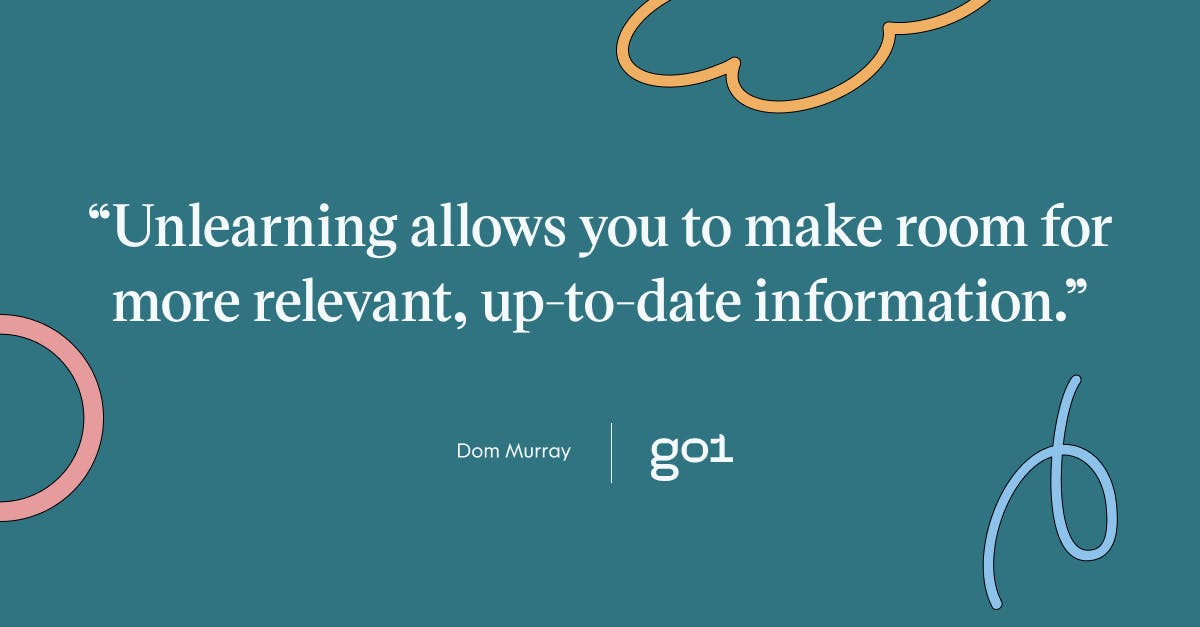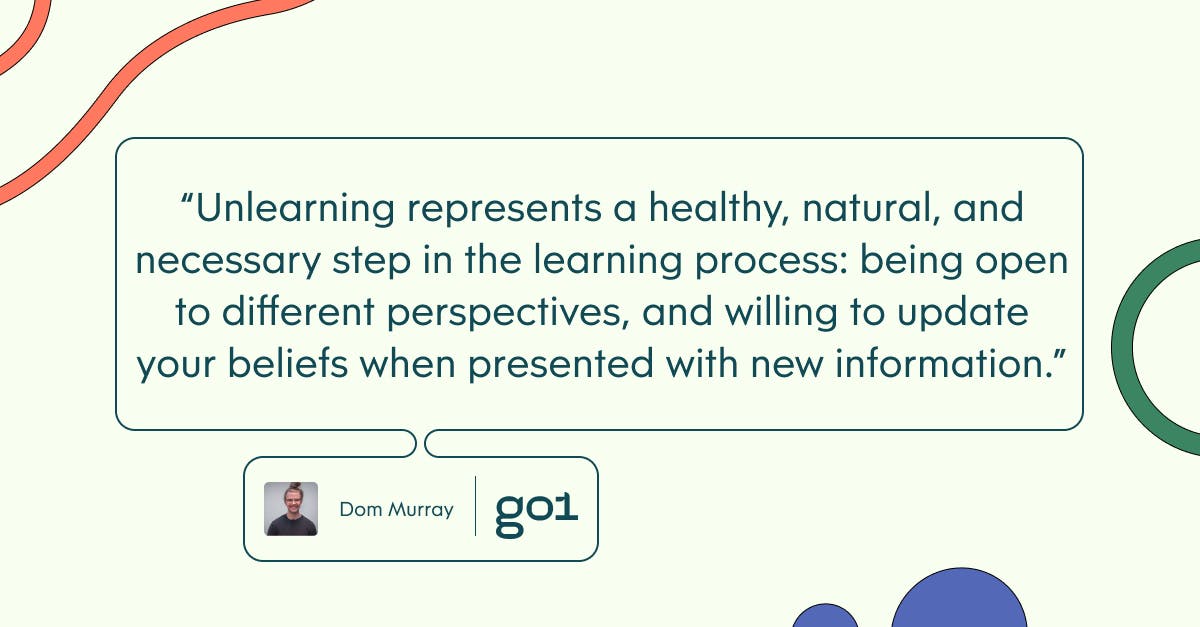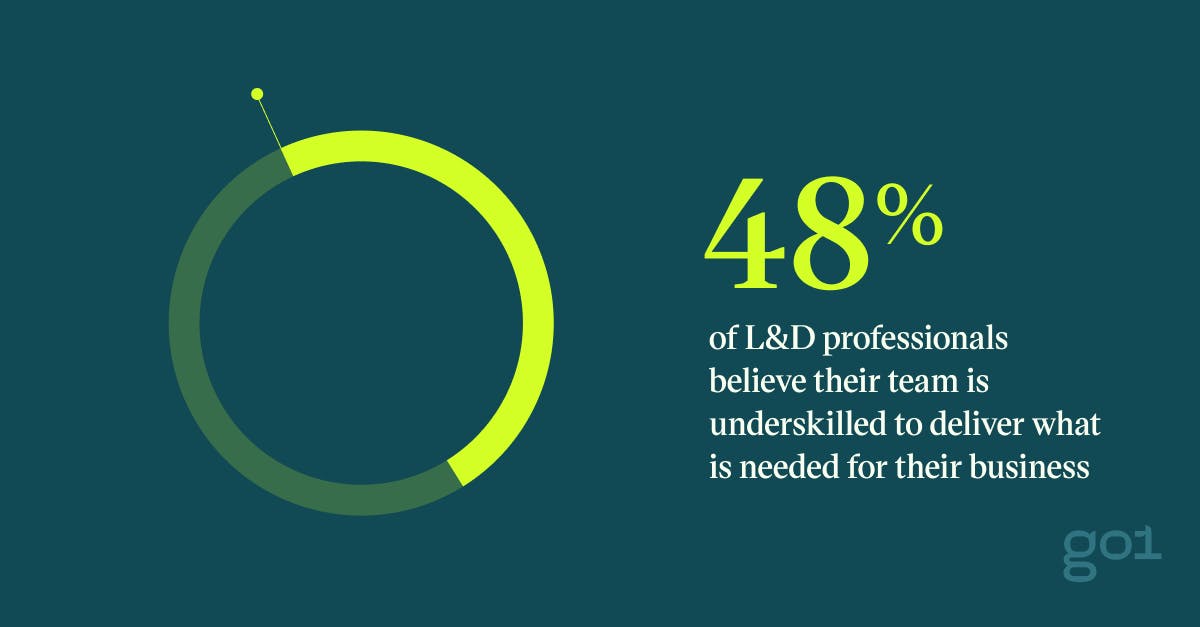
What is the learn, unlearn, relearn cycle?

A new year often heralds a host of exciting changes: resolutions, renewed hope, and, most importantly, new opportunities to learn. At Go1, few things excite us more than lifelong learning. However, these days, that outlook might need a slight rethink. While they say you learn something new every day, if current trends continue, this might be the year of unlearning.
For many of us, this will sound immediately counterintuitive. Unlearning. It just feels wrong. After all, most people have been conditioned to value continuous, ‘acquisitive’ learning. We yearn for new information, and rightly cherish that knowledge when it comes along. If you’ve worked hard to learn something, why would you want to unlearn it?
The answer is actually quite simple. Although we probably all know of someone who thinks they do, nobody knows everything. The human brain has a finite capacity. In overly simplistic terms, to make room to learn something new, you’ll usually have to discard some older, outdated information.
Take a step back, and you’ll begin to realise how valuable unlearning can be. You’re doing it all the time — probably without even realising it. That’s the nature of a changing world. Think of unlearning as a software update. Your devices need constant updates, so why wouldn’t your knowledge?

So, to help say 'out with the old and in with the new', we’re kicking off our quarter-long theme of Making L&D Sustainable by asking what is the learn, unlearn, relearn cycle? We’ll offer examples of unlearning, before examining the role of unlearning and relearning in the current L&D landscape, and offering tips to help your team embrace the learn, unlearn, relearn cycle.
Adjusting to unlearning
While at first glance the idea of unlearning may feel wrong, it isn’t as scary as it sounds. To get a common misconception out of the way, unlearning doesn’t mean dumbing things down or tossing out knowledge for no reason. Rather, unlearning allows you to make room for more relevant, up-to-date information.

Examples of unlearning
Sometimes, you’ll unlearn little things. For example, you probably grew up learning that Pluto is a planet. Then, all of a sudden, you had to unlearn that, because it was no longer a planet. That’s just one of many examples. You may move countries and unlearn local customs, like driving on a certain side of the road. Maybe as a child, you were told that eating carrots will help you see in the dark, only to find out later in life that isn’t true (no matter how many carrots you eat).
You can also unlearn and relearn new skills, like how to cope with working from home instead of working in the office, or how to best optimise SEO since Google updated their algorithm.
Other times, unlearning can mean updating your beliefs and values to be more tolerant, diverse, and inclusive when presented with new information or a new perspective.
Far from throwing away hard-earned knowledge for no reason, unlearning represents a healthy, natural, and necessary step in the learning process: being open to different perspectives, and willing to update your beliefs when presented with new information that challenges previously-held conceptions.

Just think, if humans weren’t in the business of unlearning, relearning, and continuously updating knowledge, we’d still believe the earth is flat, leeches are a medicinal miracle, and tomatoes are evil and poisonous.
What is the learn, unlearn, relearn cycle?
As mentioned, the process of unlearning and relearning has been around as long as humans have been learning. They go hand in hand. However, the formal idea of a learning cycle involving learning, unlearning, and relearning was popularised by American writer and futurist Alvin Toffler, who posited that “by instructing students how to learn, unlearn and relearn, a powerful new dimension can be added to education…Tomorrow's illiterate will not be the man who can't read; he will be the man who has not learned how to learn.”
At its core, the learn, unlearn, relearn cycle is self-explanatory. The name isn’t a trick, it’s exactly what it sounds like. For example, you may learn how to use an everyday communication tool like Gmail. Over time, you get used to the layout and interface. This is a skill you have learned. You might even consider yourself an expert. Then, one day, Gmail updates its interface. As a result, you have to unlearn the old layout and relearn the new one, to ensure your skills remain current and relevant in a changing world.
It might help to take a second to reflect on everything you had to unlearn in 2020, to show just how common this phenomenon is. In a year of unprecedented change and copious ‘new normals’, you probably had to unlearn a lot.
Unlearning vs acquisitive learning
Unlearning can be challenging at first because many of us have been taught to practice ‘acquisitive’ learning. That is, constantly acquiring new knowledge, piling facts one on top of another. In contrast, the learn, unlearn, relearn cycle engages more critical thinking skills, encouraging you to continually analyse, evaluate, and challenge knowledge to ensure it is relevant and up-to-date.
In simple terms, our ability to unlearn and relearn comes down to neuroplasticity — the foundation of a growth mindset. According to Very Well Mind, “today, it's understood that the brain possesses the remarkable capacity to reorganise pathways, create new connections, and, in some cases, even create new neurons—a concept called neuroplasticity, or brain plasticity.”
As with most things, this ability becomes easier with practice, so there’s no time like the present to train your brain to learn, unlearn, and relearn.
Unlearning for L&D: changing values for a changing world
While the learn, unlearn, relearn cycle has been important for a long time, its relevance has accelerated in recent years. As such, 2021 looms as the year of unlearning and relearning. This is especially true for L&D practitioners. It’s safe to say that in 2021, those who are unwilling to continually unlearn and relearn are at risk of being left behind.
Why is adopting the learn, unlearn, relearn cycle so important? In our deep dive into Digital Foundations last quarter, we discussed at length the rapid changes L&D needs to make to keep up with digital transformation. To name a few, according to Fosway Group, 94% of L&D professionals had to change their strategy due to COVID-19, with only 5% expecting their strategy to revert to what it was pre-pandemic. Additionally, according to Chief Learning Officer magazine, most respondents agree that their company will adopt new training methods (50%) and that their company’s blend of training methods will change (51%).
Skill requirements for unlearning
Skill requirements are also in a state of flux. 48% of L&D professionals believe their team is underskilled to deliver what is needed for their business while 79% of CEOs concerned that a “lack of essential skills in their workforce is threatening the future growth of their organisation.” In both instances, the learn, unlearn, relearn cycle can help. Further, 54% of employees will require extensive upskilling or reskilling by 2022, with soft skills replacing hard skills as a top priority for future-ready employees. This process will involve unlearning old skills and relearning new ones.

Collectively, this paints a picture of an industry undergoing significant changes at both a strategic and skills level. Implementing and embracing these changes will require significant amounts of unlearning and relearning. It is no longer enough to say you know something and assume that knowledge will remain constant for the next twenty years. Rather, you must continually reevaluate knowledge and relearn skills to ensure they remain up-to-date in a changing world.
Helping your team accept unlearning and embrace relearning
As ever, putting the learn, unlearn, relearn cycle into practice is where issues can arise. Many people are set in their ways, while for others, the proposition of unlearning may feel intimidating or challenging. Relearning can be just as difficult. Many of us are resistant to change, after all.
There are two keys to getting team members to embrace the learn, unlearn, relearn cycle.
1. Clearly communicate the ‘why’
If you simply walk in and announce ‘forget everything you thought you knew about L&D’, expect some pushback. Instead, it is vital to clearly communicate the learn, unlearn, relearn cycle to team members, and, more importantly, why it will benefit them. In doing this, it’s also important to dispel any common misconceptions that may arise. For example, unlearning means deliberately throwing away knowledge.
Emphasise that we are unlearning and relearning all the time and that doing so is necessary to keep up with a changing L&D landscape. It can help prompt people to reflect on skills or behaviours they have had to unlearn or relearn recently, so they can relate this cycle back to personal experiences. Often, resistance to change comes from people not fully understanding why that change is necessary, so be sure to clearly communicate the benefits of unlearning and relearning to your team, while also encouraging them to check in with their skills to ensure they are future-ready.
2. Provide resources and support to facilitate unlearning and relearning
Once team members are over the initial hurdle of accepting why unlearning and relearning are necessary, it’s also important to provide the appropriate resources to facilitate this learning. This means offering team members relevant, up-to-date learning opportunities and creating a culture that embraces continuous learning. Managers and leaders should be heavily involved in this process, championing the learn, unlearn, relearn cycle, and providing support wherever appropriate.
For more insights, be sure to subscribe to the Go1 newsletter to stay on top of all the latest L&D trends. Or, you can book a demo today to find out how Go1 can help with your team’s learning needs.




